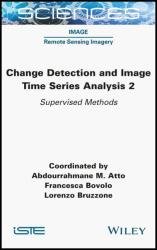 Название: Change Detection and Image Time Series Analysis 2: Supervised Methods
Название: Change Detection and Image Time Series Analysis 2: Supervised MethodsАвтор: Abdourrahmane M. Atto, Francesca Bovolo
Издательство: Wiley-ISTE
Год: 2021
Страниц: 272
Язык: английский
Формат: epub
Размер: 10.2 MB
Change Detection and Image Time Series Analysis 2 presents supervised machine-learning-based methods for temporal evolution analysis by using image time series associated with Earth observation data. Encouraged by the latest developments in Machine Learning and computer vision, Deep Learning approaches have successfully been applied to EO data. These techniques offer new opportunities for classification tasks, whose main advantage is to automate the extraction of a discriminative and informative feature representation. Thus, there is no need for feature engineering. In the context of EO time series analysis, the exploration of deep methodologies is still a young, but swiftly evolving research area.
Given the temporal structure of SITS data, the first remote sensing approaches have explored the use of deep recurrent neural network (RNN) architectures, which effectively handle sequential data. RNNs have thus been the most investigated architecture for the classification of optical and radar EO time series.
These works usually use the raw SITS data as input, for which the spatial and/or spectral dimensions are not considered. However, another well-known deep learning approach, convolutional neural network (CNN), is intrinsically designed for extracting spatial features from two-dimensional image data. Hence, CNNs have been combined with RNN to extract spatio-temporal feature representation. Research works in remote sensing include the merging of spatial and temporal representations, the consecutive learning of temporal and spatial representations and the use of dedicated architecture such as ConvLSTM. The use of the spatial structure of SITS lies outside the scope of this chapter and is thus not elaborated further.
More recently, CNNs have been adapted to make the most of the temporal structure of time series. The main difference with CNN used for two-dimensional image data is the use of one-dimensional convolution applied to the temporal dimension of the data. They have also been applied successfully to SITS data.
In the Chapter 2, we focus on how the two well-established one-dimensional CNN and RNN work. We do not cover the most recent advances, including the use of attention mechanisms4, for which there are only few recent applications to EO time series. Before describing both CNN and RNN, we begin this section by briefly introducing deep neural network theory.
Chapter 1 addresses the fusion of multisensor, multiresolution and multitemporal data. It proposes two supervised solutions that are based on a Markov random field: the first relies on a quad-tree and the second is specifically designed to deal with multimission, multifrequency and multiresolution time series.
Chapter 2 provides an overview of pixel based methods for time series classification, from the earliest shallow learning methods to the most recent deep-learning-based approaches.
Chapter 3 focuses on very high spatial resolution data time series and on the use of semantic information for modeling spatio-temporal evolution patterns.
Chapter 4 centers on the challenges of dense time series analysis, including pre processing aspects and a taxonomy of existing methodologies. Finally, since the evaluation of a learning system can be subject to multiple considerations,
Chapters 5 and 6 offer extensive evaluations of the methodologies and learning frameworks used to produce change maps, in the context of multiclass and/or multilabel change classification issues.
Скачать Change Detection and Image Time Series Analysis 2: Supervised Methods